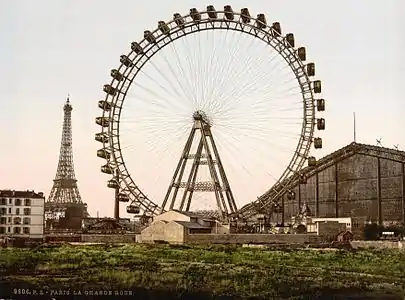Grande Roue de Paris
The Grande Roue de Paris was a 100-metre (328 ft) tall Ferris wheel built in 1900 for the Exposition Universelle world exhibition at Paris. Financing the "Grande Roue de Paris" happened by the creation of the "Paris Gigantic Wheel and Varieties Company" and selling the shares of this company.[1]



It was the tallest wheel in the world at the time of its opening. The passenger cars were so large that they were removed from the wheel and used as homes for French families when the region was devastated by World War I.[2]
Théodore Vienne, the industrialist and founder of the Paris–Roubaix cycle race, was both owner and director of the Grande Roue de Paris.
It was disassembled in 1920[3] and rag-and-bone merchants used the pods as huts to carry on their trade. This evolved, through second-hand shops, into the antique trade that is now to be found on the site and known as the Swiss Village. The remains of the wheel were finally sent for scrap in 1937. Almost 90 years passed between its construction and a taller wheel, the 107.5-metre (353 ft) Cosmo Clock 21, being built in Japan.
References
- "The Paris Gigantic Wheel and Varieties Company Limited". Retrieved 2018-12-10.
- New York Times Picture Section 5, Sunday, April 3, 1921
- Anderson, Norman D (1992). Ferris wheels: an illustrated history. Popular Press. p. 141. ISBN 9780879725327.
External links
| Wikimedia Commons has media related to Grande Roue de Paris. |
- La Grande Roue de 1900 à Paris
- French wiki article re: Swiss Village
- English website from the Swiss Village in Paris
| Preceded by Great Wheel |
World's all-time tallest Ferris wheel 1900-1989 |
Succeeded by Cosmo Clock 21 |
| Preceded by Great Wheel |
World's tallest extant Ferris wheel 1900-1920 |
Succeeded by Wiener Riesenrad |